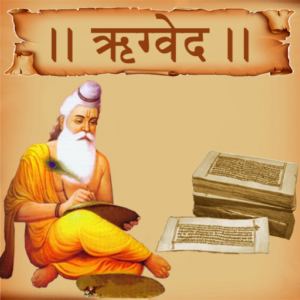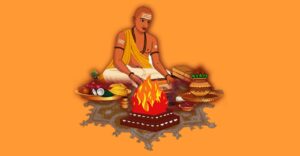Vedic Literature of the Ancient India is one of prominent source of the knowledge about Vedic age or period . it helps us to understand the lifestyle of that period , their society , administration , religious beliefs as well as other important information.
The word Veda is derived from the Sanskrit word Veda meaning, to know or knowledge par excellence.
Vedic texts are divided between Sruti (based on hearing), which is distinct from Smriti (based on memory).
Four Vedas and their Samhitas, the Brahmanas, the Aranyakas and the Upanishads form a class of literature known as Sruti
Rig Veda

Vedic Literature of the Ancient India
It is divided into 10 Books or Mandalas. Books II to VII are considered the oldest. Book I, VIII and X seem to be later additions.
A collection of 1028 hymns of a number of priestly families. ·
Written between 1700-1500 B.C. when Aryans were still in Punjab.
Books II to VII are earliest and are also called as family books. They are attributed to Gritsamada, Visvamitra, Vasudeva. Am. Bhardwaj, Vashishtha. Kanva and Angiras.
The IX Mandala is dedicated exclusively to Soma
The X Mandala contains the famous Purushsukta hymn that explains the origin of four Varnas.
Yajur Veda

Vedic Literature of the Ancient India
A ritualistic Veda.
It is divided into Shukla Yajurveda and Krishna Yajurveda.
Written in prose, it deals with procedure for performance of sacrifices and contains rituals as well as hymns.
Sama Veda
Sam Veda derives its roots from Saman. which means a melody.
A collection of melodies.
A collection of 1603 hymns. Except 99, all others were derived from Rig Veda.
Atharva Veda
A collection of 711 hymns, it is divided into 20 Kandas.
It is the latest Veda.
Atharva Veda is a book of magical formula.
It contains charms and spells to ward-off evil and disease.
Its content throws light on the practices of non-Aryans.
Upanishad
The term Upanishad indicates knowledge acquired by sitting close to the teacher. They consisted of discussions on several problems such as the creation of the universe, the nature of God. the origin of mankind etc. They are anti-ritualistic and define the doctrine of Karma (Action), Atman (Soul) and God (Brahma).
They are spiritual and philosophical in nature.
They are called the Vedanta or the end of Vedas.
There are 108 Upanishads. Generally, the period from 800 to 500 BC is known as the period of Upanishads.
- The Aitareya and Kaushitaki Upanishads belong to Rig Veda.
- Chhandogya and Kena Upanishad belong to Sama Veda.
- Taittiriya. Katha and Svetasvatara Upanishad belong to the Krishna Yajur Veda.
- Brihadaranyaka and Isa belong to the Shukla Yajur Veda
- Prasna. Mundaka and Mundukya belong to the Atharva Veda.
Ashrama
The ashrama system is found mentioned for the first time in the Aitareya Brahman
Meant mainly for regulating the life of the male members of the higher castes, they consisted of four stages:
(a) Brahmacharin or student life;
(b) Grihastha or life of the householder;
(c) Vanaprastha or partial retirement and
(d) Sanyasin or complete retirement (ascetic life).
Full recognition of the fourth stage was done only in the post-Vedic period.
Kalpa Sutras
These are the treatises dealing with Vedic rituals on one hand, and with customary law on the other They are written in a laboriously compressed style, sometimes approaching the structure of algebraic formulas, unintelligible without the help of authoritative commentaries. With a view to conveying to the future generations the ancient and contemporary literature,
the Aryan sages invented a special concise method called the Sutra style. Thus the massive Vedic texts were condensed into short, terse formulae, which could be easily remembered and transmitted orally – from father to son or from Guru to Shisya.
Most of the Vedic literature was handed down orally in this manner.
The Sutra literature is divided into three classes:
(a) Srauta Sutras – dealing with large public sacrifices.
(b) Griha Sutras: dealing with rituals connected with birth, naming, marriage etc.
(c) Dharma Sutras – explain social and local customs. which later on became the basis of Manu Smriti.
Dharma – Shastra
Dharma-Shastras are the later Vedic Age or Epic Age treatises on ethical and social philosophy. They deal systematically with the proper conduct of life and describe social, ethical and religious obligations.
The Dharma-Shastras are, in fact, another name for Smritis, which are the law books, written in the shloka style
The chief among them are the Manav Dharma Shastra, the Vishnu Dharma Shastra. the Yajnavalkya Smriti. and the Narad Smriti.
Manav Dharma Shastra or Manu Smriti is the oldest and the most famous.
Its author Manu is supposed to be the first king and the first law-giver.
Later on, some minor Smritis and commentaries like the Mitakshara were compiled. These books are not merely accounts of civil and criminal laws of the time but they also cover all aspects of the daily life of the individual.
They throw considerable light on the social and political life of the age -the caste system, Ashramas of life, economic conditions as also state of professions, arts and crafts, architecture and the working of administration.
Vedangas
In order to understand the Vedic Literature, it was necessary to learn-Vedangas or the limbs of Vedas.
These are treatises on science and arts.
They are
- a. Shiksha (Phonetics)
- b. Kalpa (Ritual)
- c. Vyakarana (Grammar)
- d. Chhand (Metrics)
- e. Nirukta (Etymology)
- I. Jyotisha (Astronomy)
Yaska’s Nirukta (5th century BC) is the oldest Indian linguistic text.
Panini wrote Ashtadhyayi (4lhCentury BC) on Vyakaran
Upvedas
There were four Upveda
Ayurveda dealing with medicine
Dhanurveda dealing with the art of the warfare
Gandharvaveda dealing with music
Shilpaveda dealing with art and Literature
Epics
Mahabharata is older compared to Ramayana and possibly reflects the state of affairs from 10th Century BC to 4th Century . AD.
Originally Mahabharata consisted of 8800 verses and was called Jayasamhita’. These were raised to 24000 and came to be known as Bharata. The final compilation brought the number of verses to 100,000 and came to be known as Mahabharata.
The Ramayana of Valmiki originally consisted of 6000 verses which were raised to 12000 and finally to 24.000
Composition of Ramayana started in 5th century BC. It passed through several stages and attained its present form as late as 12th century AD.
Six System of Philosophy
1 Nyaya (Analysis) Gautam
2 Vaisesika (Atomic Characteristic) Kanada
3 Sankhya (Enumeration) Kapil
4 Yoga (Application) Patanjali
5. Purva Mimansa (Enquiry) Jaimini
6 Uttar Mimansa (Vedanta) Vyas








No comment